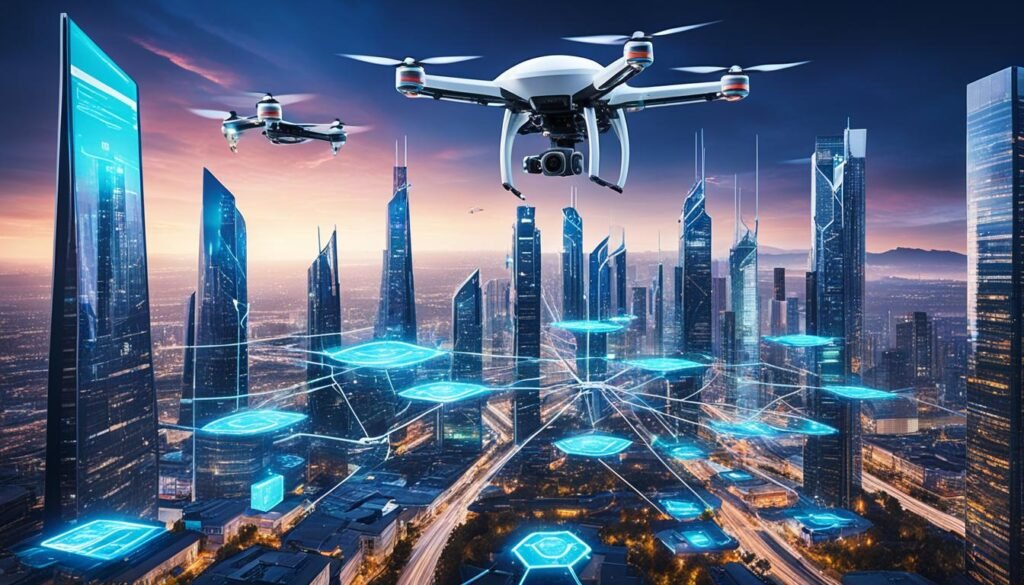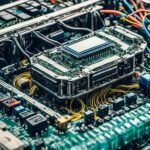Did you know there will be over 30 billion connected devices by 2024? This shows how big a role embedded systems play in our world. We’ll look at the top trends for these systems in 2024. You’ll see how IoT, artificial intelligence, and edge computing are changing tech.
The future of embedded systems is about making things work better together. It’s about making things that fit into our lives well. We’ll talk about the latest in these systems and what they mean for the future.
Knowing about the latest in embedded systems is key in today’s tech world. These systems are in many devices we use every day. This article will cover new advancements and look ahead to the future of embedded systems. We’ll see how they’re used in different areas.
Key Takeaways
- The number of connected devices is set to hit 30 billion by 2024, underscoring the importance of embedded systems.
- Innovations in IoT are driving the evolution of embedded technologies.
- Artificial intelligence is enhancing capabilities in embedded systems.
- Edge computing is paving the way for greater efficiency and response times.
- Cybersecurity measures are becoming more critical as systems scale up.
- Real-time operating systems are essential for efficient performance.
- Firmware development trends will focus on increasing versatility and security in embedded systems.
Introduction to Embedded Systems
Embedded systems are special computers that work in bigger systems. They do specific jobs. You find them in many things, from simple gadgets at home to complex machines in factories.

These systems have three main parts: microcontrollers, memory, and ways to get in and out data. Microcontrollers are like the boss, telling the system what to do. Memory keeps important info and instructions. And interfaces let the system talk to other devices.
Embedded systems are everywhere in our lives. In cars, they control the engine and entertainment systems. They also help with safety features. In hospitals, they’re in devices like pacemakers and tests.
At home, they make our appliances smarter. Things like fridges and thermostats work better because of them.
These systems are very reliable and efficient. They make things work better and more innovatively. This is why they’re so important in many areas.
| Component | Function |
|---|---|
| Microcontroller | Serves as the central processing unit, governing the tasks and operations. |
| Memory Unit | Stores essential data and instructions, including RAM and ROM categories. |
| Input/Output Interfaces | Facilitates communication between the embedded system and other devices or actuators. |
The Importance of Embedded Systems in Modern Technology
Embedded systems are key to modern tech. They help make many devices work better and more efficiently. They are very important because they are used in so many areas.

In healthcare, cars, and planes, embedded systems are a must. They help control and check important processes. For example, in cars, they help make systems like automatic driving and safety features work.
The Internet of Things (IoT) has made embedded systems even more important. Now, more devices can talk to each other and share data. This shows how vital embedded systems are for making these devices work together.
Now, making things easier for users is a big focus. Embedded systems help make devices like phones and smart home gadgets work better. This makes using them a smoother experience for everyone.
- Healthcare: Embedded systems help control medical devices, making patient care better.
- Automotive: They are key for safety features and self-driving cars.
- Aerospace: These systems make aircraft systems reliable and efficient, making flying safer.
Embedded systems keep pushing tech forward. They make sure things work well together. Knowing about them and the latest in IoT is key for tech pros. This shows that embedded systems are leading the way in tech.
Embedded Systems and Key Trends in 2024
The year 2024 will bring big changes to embedded systems. These changes will come from new tech in IoT and edge computing. These trends will make things work better, faster, and safer.
Growing Influence of IoT Integration
IoT is changing embedded systems a lot. More devices are talking to each other, so handling data fast is key. This lets things work better and faster.
But, it also means we need strong cybersecurity measures. We must keep data safe and secure.

Advancements in Edge Computing
Edge computing is getting popular because it makes things faster. It does tasks closer to where the data is. This means quicker responses and better use of resources.
This leads to better efficiency and highlights the need for strong security. So, the market for embedded systems is expected to grow. This is thanks to the use of edge computing.
Artificial Intelligence Applications in Embedded Systems
Artificial intelligence has changed how embedded systems work. It adds smart thinking to devices, making them work better and more efficiently.

Machine Learning Capabilities
Machine learning lets embedded systems look at lots of data, understand it, and make choices on their own. For example, in making things, AI helps find problems fast, cutting down on wasted time and making more stuff.
These smart sensors get better at spotting patterns over time.
Automation and Autonomy Enhancement
AI makes automation in embedded systems much better. Self-driving cars use AI to safely move around, thanks to smart systems inside. In hospitals, AI helps watch over patients, spot health issues early, and alert doctors.
AI is making embedded systems smarter and more independent. This is changing many industries for the better.
Real-time Operating Systems: A Vital Component
Real-time operating systems are key in embedded systems. They make sure systems react fast to inputs or events. They are vital for tasks like medical devices, car safety systems, and industrial control.
The kind of RTOS used affects how well a system works. FreeRTOS is popular for its ease and small size. VxWorks is known for being very reliable and fast.
Each RTOS type has its own strengths for different uses. FreeRTOS is great for small devices like fitness trackers and sensors. VxWorks is used in big projects like spacecraft and complex robots.
Real-time operating systems ensure that embedded systems can meet strict timing constraints, providing a predictable and reliable response.
Choosing the right RTOS is crucial for embedded systems. In medical devices, they help save lives by processing data fast. In car safety systems, they control things like airbags and avoiding crashes.
In short, real-time operating systems play a big role in making embedded systems work well. They help with efficiency, reliability, and fast action in many industries.
Firmware Development Trends for 2024
The world of firmware development is changing fast in 2024. We’re seeing a big move to agile ways of working. Agile lets teams work better and improve their work step by step. This fits well with the changing needs of embedded technology.
Now, making sure each update works well is key. We use continuous testing and automation to do this. These methods help fix bugs fast and make systems more reliable. They also make making new firmware quicker and cheaper.
Another big change is towards making firmware more modular. This means it’s easier to add new stuff or fix things without a big update. It helps with making embedded systems grow by making updates and adding features simpler.
These changes are pushing innovation in embedded technology forward. They let developers quickly tackle new problems and chances. This makes firmware better and helps it grow in the market.
To sum up the main trends:
- Adoption of agile methodologies
- Implementation of continuous integration and automated testing
- Emphasis on modularity for better scalability and updates
These trends make embedded systems better and help them grow. Keeping up with these changes is important for developers who want to stay ahead in firmware development.
Cybersecurity Measures for Embedded Systems
Embedded systems are now key parts of our critical infrastructure. They need strong cybersecurity to stay safe from new threats. This means designing them with security in mind and following new rules.
New Regulations and Standards
New rules are coming to make sure embedded systems are safe. In cars, ISO 21434 sets up a plan for cybersecurity from start to finish. It requires managing risks in a way that fits car systems.
In healthcare, the FDA has rules for cybersecurity. These rules focus on keeping patients safe and data secure. Device makers must add strong security early on to follow these rules. These rules help protect important data and keep trust.
Challenges and Solutions in Cybersecurity
Embedded systems are hard to secure because they have limited resources and are used in many ways. But, there are now ways to protect them without slowing them down. These are called lightweight cryptography solutions.
To keep cybersecurity strong, we need to do many things. Following new rules like ISO 21434 is key. Using real-time threat detection, secure boot, and updating software often helps fight cyber threats. Teaching developers more about cybersecurity is also very important.
Adding strong cybersecurity to system design is a must today. By doing this, we make sure important systems in many areas stay safe and work right.
Industry 4.0 Advancements and Embedded Technology
Industry 4.0 has started a new era of big changes in technology. It brings new ways to make things work better and smarter. Embedded technology is key in this change. It lets us watch and control things in real time.
One big change is how IoT integration has changed making things. Now, smart factories use sensors and IoT devices. They can check on equipment, predict when it needs fixing, and plan better production times.
This makes factories work better and more efficiently. It cuts down on time when things stop working and makes more things.
Embedded technology also helps with moving things around. In supply chains, IoT helps track goods, manage stock, and plan better routes. This makes moving things around smoother and cheaper.
In cities, we see Industry 4.0 in things like smart traffic and buildings. IoT devices give real-time data for better city management. This makes cities safer, greener, and better for people living there.
Big companies like Bosch and Siemens show how embedded technology changes things. Bosch uses IoT in its smart factories for top efficiency and quality. Siemens uses it in logistics for fast and smart delivery.
There’s a big need for more Industry 4.0 solutions. As companies adopt this new tech, the role of embedded systems and IoT gets clearer. The future looks bright with more connections and efficiency in industries.
Market Growth for Embedded Systems
The market for embedded systems is growing fast. It’s expected to jump from US$ 14.8 billion to US$ 23.8 billion by 2028. This shows a strong growth trend. Many factors are pushing this growth, making embedded tech important in many areas.
Cars are leading this growth. They need more embedded systems for things like self-driving cars and safety features. This makes the market for embedded software grow a lot.
Factories are also driving growth. They use smart machines that work with embedded tech. This makes them work better, faster, and more precisely.
Smart homes are another big area. They use embedded tech for things like lights and security. People want more convenience and automation at home, which is making this market grow.
Looking closer, we see the embedded software market keeps growing. It offers solutions for many needs, showing its key role in tech progress. The mix of new ideas and demand looks bright for embedded systems.
| Year | Market Size (US$ Billion) | Factors Driving Growth |
|---|---|---|
| 2020 | 14.8 | Initial boost in IoT and consumer electronics |
| 2024 | 19.5 | Rising demand for industrial automation |
| 2028 | 23.8 | Expansion of automotive and smart home markets |
This data shows the market’s growth and what’s driving it. It helps people understand the future of embedded systems. By knowing these trends, companies can find new chances in the embedded software market.
Key Challenges Facing Embedded System Developers
Embedded system developers face many challenges today. The systems are getting more complex. They have to work with more advanced features and parts.
They also need to make systems work fast and use little power. This means they must be very precise and efficient. Plus, they have to follow strict rules and standards.
Choosing the right programming languages is hard too. C, C++, and Python are some options. But, picking the best one depends on the project and the skills of the developers. Using good development methods helps a lot.
There are ways to overcome these challenges:
- Prioritizing modular design to simplify system updates and scalability.
- Implementing robust testing frameworks to ensure high-quality and compliant products.
- Continuous learning and adaptation to keep up with the latest industry trends and technologies.
By tackling these challenges, embedded system developers can work better and make products that meet today’s needs.
Future of Embedded Systems: Predictions for 2024
As we get closer to 2024, the future of embedded systems looks bright. We’ll see big changes thanks to new tech like AI, IoT, and edge computing. These will make embedded systems even more important in our daily lives.
AI will make embedded systems smarter. They’ll be able to analyze data and make quick decisions on their own. This will help in many areas like healthcare, cars, and factories.
IoT will make embedded systems even more powerful. Things like smart homes and wearables will talk to each other better. Developers need to make sure their systems can grow with new tech and what people want.
Edge computing is another big change. It means processing data right where it happens, making things faster and safer. This will lead to more use in things like self-driving cars and remote health monitoring.
The future of embedded systems will need constant innovation and flexibility. Those who keep up with tech changes will have a big advantage. It’s a time full of chances to grow and improve, making it exciting and tough at the same time.
For 2024, we see embedded systems playing a big role in tech. With AI, IoT, and edge computing getting better, their impact will be huge. By embracing these changes, embedded systems will keep leading the way in tech.
Conclusion
Embedded systems are changing the way we live and work. They are key to modern progress. Trends in 2024 show us how important it is to have systems that think and connect well.
This knowledge helps you understand the changing world of embedded tech. It’s important for anyone who wants to use these systems well.
Artificial intelligence is making embedded systems smarter. This means they can do more and help in many areas. Knowing about this change is key for using embedded systems fully.
Think about how these new techs might change your work or dreams. The future of embedded systems is bright and full of new ideas. Keep learning about this important tech as it changes our world.
FAQ
What is an embedded system?
An embedded system is a special kind of computer. It does specific tasks in bigger systems. It has parts like microcontrollers, memory, and ways to get in and out data. You can find it in things from gadgets to big machines.
Why are embedded systems important in modern technology?
Embedded systems make things work better and more efficiently. They help bring together IoT and smart tech in many areas. This makes things run smoother and brings new ideas to life.
What are the current trends in embedded systems for 2024?
For 2024, embedded systems are getting more connected through IoT. They’re also getting smarter with better AI. These changes are making embedded tech more powerful and growing its market.
How does IoT integration affect embedded systems?
IoT makes more devices talk to each other, speeding up data sharing. This helps embedded systems work better in many areas. It’s key for their efficiency and how well they do their jobs.
What role does artificial intelligence play in embedded systems?
AI makes embedded systems smarter by letting them learn and make choices on their own. This helps them work better and improve how they interact with us, making things more automated and user-friendly.
What are real-time operating systems (RTOS), and why are they important?
Real-time operating systems (RTOS) are needed for tasks that must happen fast. They keep systems like cars and medical devices reliable and working well.
What are the main challenges developers face in embedded systems?
Developers struggle with complex systems, needing fast responses, and following rules. They also have to work efficiently and use different programming languages well.
What is the future outlook for the embedded systems market?
The embedded systems market is expected to grow a lot, from US$ 14.8 billion to US$ 23.8 billion by 2028. This growth is thanks to new tech in cars, factories, and smart homes.
How important is cybersecurity in embedded systems?
Cybersecurity is very important in embedded systems because of new threats and rules. It’s crucial in areas like cars and health care. Good security steps are needed to keep devices safe and reliable.
Source Links
- Embedded systems in 2024: Key trends and predictions – Blog Solwit – https://solwit.com/en/blog/embedded-systems-in-2024-key-trends-and-predictions/
- The Future of Embedded Systems in 2024 and Beyond – Unveiling Emerging Trends and Technologies – https://www.linkedin.com/pulse/future-embedded-systems-2024-beyond-unveiling-emerging-trends-technologies-2j7qe
- 6 Embedded Software Development Trends to Watch in 2024 – https://www.ics.com/blog/6-embedded-software-development-trends-watch-2024


